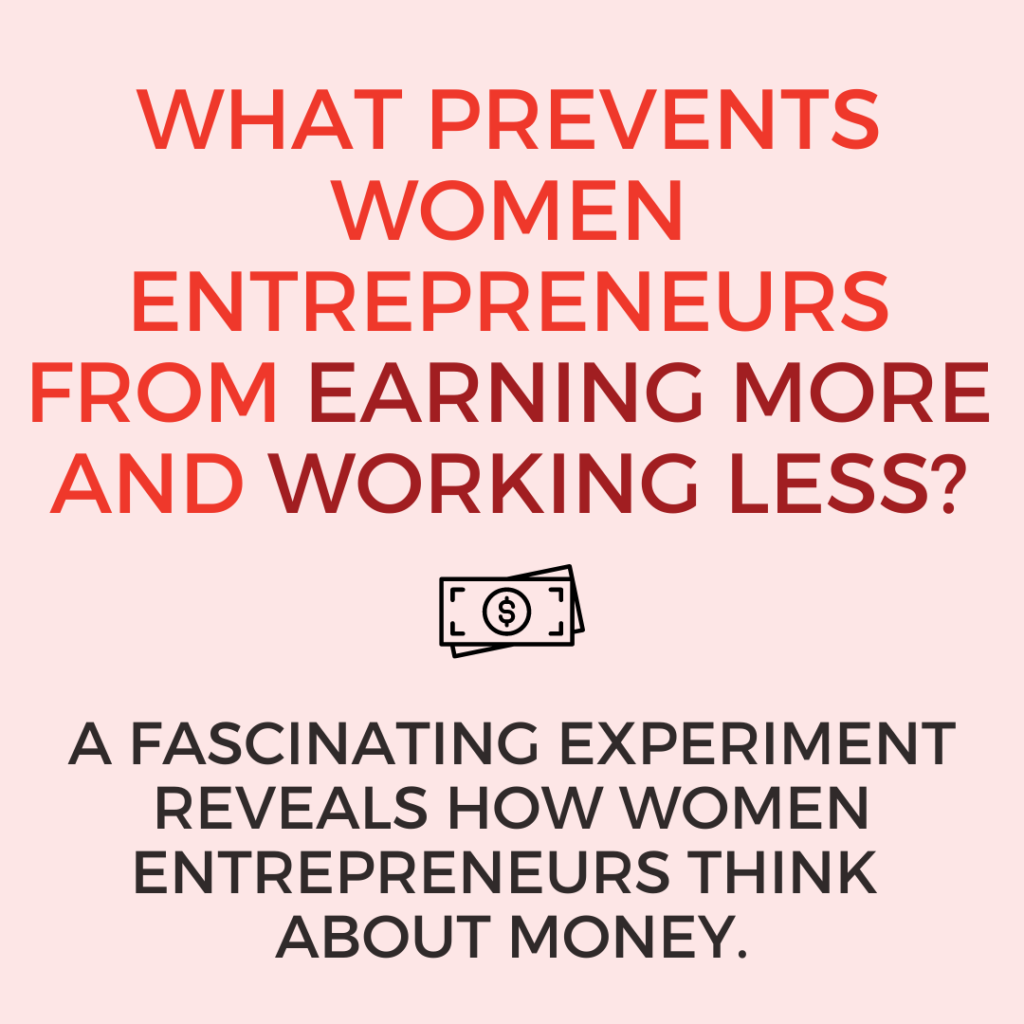Here are the results of a crazy simple experiment I ran to understand how women entrepreneurs think about money.
I asked a group of women founders I coach to brainstorm how to boost WORKING CAPITAL to fund their growth over the next 2-6 months.
“Working capital” refers to the available cash you have on hand to both a) run your business (pay bills and service debt) and b) fund initiatives to help you grow. For an explainer on what working capital is and how it impacts the growth of your business, watch this short tutorial.
For instance, you might invest your working capital to say, hire a coach, attend a conference, pay for a videographer to shoot promotional videos or build a new website.
Having enough working capital is CRITICAL if you want to grow your company. Working capital is what you use to pay for your growth. Unfortunately, women entrepreneurs have disproportionately low access to working capital, despite the fact our businesses are often more profitable than our male-owned counterparts, according to a 2022 study published in the Journal of Monetary Economics. This can lead us to “misallocate capital” (check out my video explaining what it means to misallocate capital), which researchers have found reduces the total output of women-owned firms by 4%.
To put this in context, if the 2% of all million dollar plus woman-owned US-based firms had equitable access to working capital, we’d likely see their total output increase by a minimum of $10.4B USD per year. In other words: a lack of access to working capital costs the economy and society in terms of lost opportunity, revenue and output.
Back to our experiment. In under 3 minutes, the women entrepreneurs came up with a TON of unique, actionable and PROVEN ideas to boost working capital. Their collective experience and smarts saw them generate multiple ways to create cash infusions in their businesses.
But here’s the kicker.
94% of the ideas generated required their LABOUR. (Or, if you insist, LABOR).
Examples:
- Creating and selling new offerings.
- Selling VIP days and consulting hours
- Hosting events etc.
Now. There is NOTHING wrong with using your labour to generate cash infusions in your business.
But remember what we know about how wealthy women generate riches…
THEY USE MONEY TO MAKE MORE MONEY.

Here’s an example. Guatemala born, Phoenix, AZ-based real estate mogul Michelle Bosch of Orbit Investments pools money from accredited investors to buy multi-family residential complexes worth anywhere from $6M-$30M. As a seasoned investor, Michelle could feasibly finance these investments on her own. But rather than tying up her capital – thereby limiting the volume of properties she’s able to invest in – Michelle does what wealthy women do to generate riches…they use money , especially other people’s money – to build more wealth. (Listen to my conversation with Michelle on how to grow your wealth in quantum leaps, listen to episode 473 of the Power + Presence + Position podcast).
What was so fascinating about the experiment I ran in which I invited the group of women entrepreneurs to brainstorm ways to boost working capital was what it revealed about how automatically women entrepreneurs connect MONEY and LABOUR.
Far from being outliers, this group of women entrepreneurs was in many ways representative of a larger trend of women habitually connecting “work” and “money” says Forbes contributor and CPA Melissa Houston. “Time is money – and that means for every hour you spend working, there’s a cost attached to that. It’s critical that women learn how to increase working capital without adding hours of labour to the mix.”
I call this the “Money/Labour Bias” for Women Entrepreneurs.
Why is this auto-connect a problem? There are 3 core reasons:
- The overlooked challenge of integrating scalability into your leadership approach,
- The conflation of simplicity and ease
- The fundamental lack of labour reliability (yours included).
Let’s explore.
The Overlooked Challenge of Integrating Scalability Into Your Leadership Approach
When you connect “making money” with “doing work” – you will struggle with self-inflicted scalability issues in your business. And these scalability issues will place a stranglehold on your earnings.

A few years back, an overworked consultant who was spending more than 40 hours per week working 1:1 with clients hired us to help her make the shift from 1:1 service delivery to a scalable business model. At the time, her company was generating approximately $300K USD in revenue.
Over a 12-month period, she implemented two key changes in her company that dramatically reduced her time in direct service delivery. First, she built an internal training process that equipped a team member to take over the majority of the 1:1 consulting. Second, she created a group training program that allowed her to serve multiple clients at once. Not only did double her revenue, but she reduced her time in service delivery from over 40 hours per week to 15 hours.
All good, right?
In theory yay. In practice nay. The sudden onslaught of open time felt disorienting and alien.
Because my client, like so many women entrepreneurs in service businesses, equated “making money”, “adding value” and “being productive”, with doing work, she experienced stress, identity loss and irrational fears of “losing everything” as a result of divorcing revenue from service delivery. In my client’s case, this anxiety initially caused her to look for “busy work”, rather than invest her energy in rest, fun, or bigger picture strategies to set her firm up for continued growth and innovation.

The challenge of divorcing labour from revenue is challenging even when it’s your core goal, says Dr. Janna Scharfenberg, founder of The Modern Ayverda Institute, a for-profit firm headquartered in Zurich.
From the outset, Janna set up a highly scalable business model and built internal systems that allowed her to work what many North Americans would consider part time hours, despite generating millions in revenue per year. The “inner perspective shift” required to actually give herself permission to have open time was harder.
“In the beginning, I kept myself busy all the time with all kinds of unnecessary projects and tasks in my business. Furthermore, it was an impactful experience to see how my brain was wired to being “on” and busy and how much time it really took me to enter a deep and lasting stage of relaxation – not the kind of relaxation you have after a long weekend, but more a sustainable state of being.”
Behold, the Money/Labour Bias at work.
The Conflation of Simplicity and Ease
Amongst entrepreneurs who run service-based businesses, advice related to “cash infusions” often leads to “creating and selling a simple new offering.”

When people discuss “creating a simple new offering” as a way to generate a quick and easy cash infusion, I want to laugh so hard I cry (tears of anguish). That’s because your offers don’t sell themselves; in order to actually generate revenue and thereby boost working capital, every offer needs a go-to-market plan, aka a sales funnel.
“The back-end work to set up, test, launch, tweak and report on a funnel is anything but simple,” says fractional CMO Katy Widrick. “The most effective funnels appear simple on the surface – and feel simple to your audience. But they are in fact quite labor intensive behind the scenes…like the duck that placidly glides on top of the lake while furiously paddling under the water where nobody can see.”
Conflating “simple” with “easy” is a massive mistake. Making things “simple” is in fact really hard to do. Making simple things takes time, effort and editing. As Mark Twain famously remarked, “I would have written a shorter letter, but I didn’t have time.”
Simplicity takes labour…often, much more labour than you initially expect. Therefore, boosting working capital by creating new offerings can, in some cases, negatively impact a woman entrepreneur’s ability to generate working capital.
Behold again, the “Money/Labour Bias” at work.
The Fundamental UnReliability of Labour
I originally published this essay as a shorter post on social media. The brilliant entrepreneur Sandra Shpilberg, author of the award-winning book New Startup Mindset: 10 Mindset Shifts To Build The Company Of Your Dreams commented that labour is not only unscalable, it’s unreliable.

Admittedly, her comment took my breath away for a moment. I am a coach and my job is to see the best in people. It felt harsh to describe labour as unreliable. But….FACTS.
I ask you: if labour were in fact a reliable scaling mechanism, why would we need the multibillion dollar industries of: personal productivity, manager training, team dynamics and workplace culture? I’m not saying don’t hire a team. I fundamentally believe in teams and thus the need for the multi-billion dollar industries that help us all work together better. That said, there is an inherent complexity in labour. Which means that using labour to boost working capital or create cash infusions is neither simple nor easy.
Again: the Money/Labour Bias at work on women entrepreneurs.
Thinking Beyond the Money/Labour Bias
Back to the group of women entrepreneurs who brainstormed the labour-heavy list of ideas to boost working capital. I challenged them with the insights shared in the article, and it led to an elevated and eye-opening conversation about how each of them could (and, indeed ARE) using MONEY – both their own, and other people’s – to make more money.

One by one, the women excavated their own experiences to share constructive stories about how they generated working capital. For instance, one woman broke down the pricing model she used to generate $80K in working capital to fund her company’s growth.
Another woman walked us through how she used pricing strategy to cut her labour in half while generating an additional $30K in working capital per month.
In both cases, they boosted working capital with ZERO ADDITIONAL LABOUR. (I call this a baller money move).
What this discussion revealed to us was how important it is that we create spaces where women can speak frankly and directly about money, and where women entrepreneurs are challenged to think differently about working capital.
Conclusions
Working capital is critical in financing growth, and women entrepreneurs have disproportionately low access to working capital, despite the fact our businesses are often more profitable than our male-owned counterparts, according to a 2022 study published in the Journal of Monetary Economics.
Anecdotally, women entrepreneurs are MORE likely to increase working capital with labour-driven solutions: selling consulting or creating new offerings. We define this auto-connect the “Money/Labour Bias for Women Entrepreneurs.” And we explored 3 ways in which this Money/Labour Bias can in fact be counterproductive in terms of boosting working capital to fuel growth.
The biggest question that remains for me is to understand WHY women entrepreneurs experience the Money/Labour Bias. Is it a lack of access to networks where “using money to make more money” is more common? Is it driven by systemic barriers that block women’s access to capital? These are questions I want to study and explore in greater detail in the future.
NEXT STEPS
- Reflect
Here are some reflection questions. You can journal your answers, discuss with a partner, or reflect on them privately.
What is the “Money/Labour Bias”? Define it in your own terms, based on your understanding of the essay.
How has the “Money/Labour Bias” shown up in your business and working life?
- Learn
Watch this short video tutorial to learn more about what working capital is, and 5 ways to boost working capital in your business…that DON’T require your labour. Next, watch this tutorial to understand what “capital misallocation” is and how it impacts your growth.
- Take Action
Did you get value from this article? Here’s what to do next…
Sign up for our newsletter and get deep, thoughtful and actionable insights on how to be a better entrepreneur.
Are you getting the caliber of conversation, strategic insight and support you need to grow your profit and impact in a sustainable way? If you’re not hearing about – and implementing – ways to generate cash and grow your company in a way that doesn’t involve more labour…we need to talk. Explore our coaching programs, or submit an application to explore working with us.
Did you find this article useful? If so, share it by clicking one of the buttons below!
